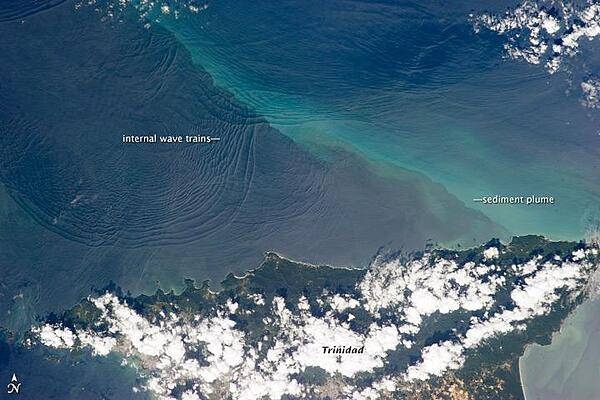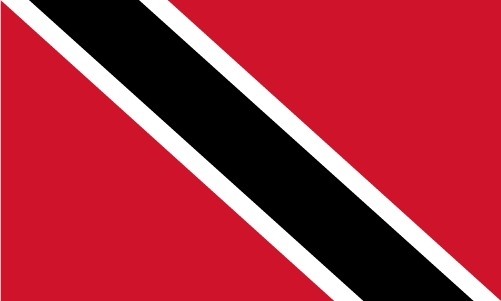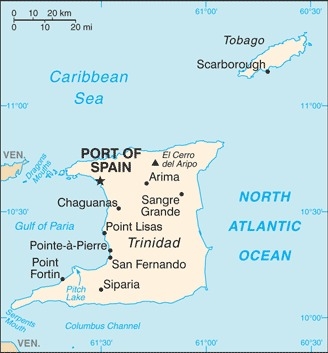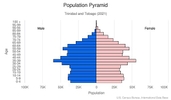Trinidad and Tobago
Introduction
Background
First colonized by the Spanish, the islands came under British control in the early 19th century. The islands' sugar industry was hurt by the emancipation of the slaves in 1834. Manpower was replaced with the importation of contract laborers from India between 1845 and 1917, which boosted sugar production as well as the cocoa industry. The discovery of oil on Trinidad in 1910 added another important export. Independence was attained in 1962. The country is one of the most prosperous in the Caribbean thanks largely to petroleum and natural gas production and processing. Tourism, mostly in Tobago, is targeted for expansion and is growing. The government is struggling to reverse a surge in violent crime.
Visit the Definitions and Notes page to view a description of each topic.
Geography
Location
Caribbean, islands between the Caribbean Sea and the North Atlantic Ocean, northeast of Venezuela
Geographic coordinates
11 00 N, 61 00 W
Map references
Central America and the Caribbean
Land boundaries
total: 0 km
Coastline
362 km
Maritime claims
territorial sea: 12 nm
contiguous zone: 24 nm
exclusive economic zone: 200 nm
continental shelf: 200 nm or to the outer edge of the continental margin
measured from claimed archipelagic baselines
Climate
tropical; rainy season (June to December)
Terrain
mostly plains with some hills and low mountains
Elevation
highest point: El Cerro del Aripo 940 m
lowest point: Caribbean Sea 0 m
mean elevation: 83 m
Natural resources
petroleum, natural gas, asphalt
Land use
agricultural land: 10.6% (2018 est.)
arable land: 4.9% (2018 est.)
permanent crops: 4.3% (2018 est.)
permanent pasture: 1.4% (2018 est.)
forest: 44% (2018 est.)
other: 45.4% (2018 est.)
Irrigated land
70 sq km (2012)
Population distribution
population on Trinidad is concentrated in the western half of the island, on Tobago in the southern half
Natural hazards
outside usual path of hurricanes and other tropical storms
Geography - note
Pitch Lake, on Trinidad's southwestern coast, is the world's largest natural reservoir of asphalt
People and Society
Nationality
noun: Trinidadian(s), Tobagonian(s)
adjective: Trinidadian, Tobagonian
note: Trinbagonian is used on occasion to describe a citizen of the country without specifying the island of origin
Ethnic groups
East Indian 35.4%, African descent 34.2%, mixed - other 15.3%, mixed - African/East Indian 7.7%, other 1.3%, unspecified 6.2% (2011 est.)
Languages
English (official), Trinidadian Creole English, Tobagonian Creole English, Caribbean Hindustani (a dialect of Hindi), Trinidadian Creole French, Spanish, Chinese
Religions
Protestant 32.1% (Pentecostal/Evangelical/Full Gospel 12%, Baptist 6.9%, Anglican 5.7%, Seventh Day Adventist 4.1%, Presbyterian/Congregational 2.5%, other Protestant 0.9%), Roman Catholic 21.6%, Hindu 18.2%, Muslim 5%, Jehovah's Witness 1.5%, other 8.4%, none 2.2%, unspecified 11.1% (2011 est.)
Age structure
0-14 years: 19.01% (male 116,953/female 112,805)
15-24 years: 11.28% (male 70,986/female 65,389)
25-54 years: 43.77% (male 276,970/female 252,108)
55-64 years: 13.83% (male 83,650/female 83,585)
65 years and over: 12.11% (male 64,092/female 82,251) (2020 est.)
Dependency ratios
total dependency ratio: 46.1
youth dependency ratio: 29.3
elderly dependency ratio: 16.8
potential support ratio: 7.4 (2020 est.)
Median age
total: 37.8 years
male: 37.3 years
female: 38.3 years (2020 est.)
Population distribution
population on Trinidad is concentrated in the western half of the island, on Tobago in the southern half
Urbanization
urban population: 53.3% of total population (2021)
rate of urbanization: 0.23% annual rate of change (2020-25 est.)
Major urban areas - population
544,000 PORT-OF-SPAIN (capital) (2021)
Sex ratio
at birth: 1.03 male(s)/female
0-14 years: 1.04 male(s)/female
15-24 years: 1.09 male(s)/female
25-54 years: 1.1 male(s)/female
55-64 years: 1 male(s)/female
65 years and over: 0.78 male(s)/female
total population: 1.03 male(s)/female (2020 est.)
Maternal mortality ratio
67 deaths/100,000 live births (2017 est.)
country comparison to the world: 85Infant mortality rate
total: 24.55 deaths/1,000 live births
male: 26.2 deaths/1,000 live births
female: 22.85 deaths/1,000 live births (2021 est.)
Life expectancy at birth
total population: 74.92 years
male: 71.83 years
female: 78.1 years (2021 est.)
Contraceptive prevalence rate
40.3% (2011)
Drinking water source
improved: total: 99.3% of population
unimproved: total: 0% of population (2017 est.)
Current Health Expenditure
6.9% (2018)
Physicians density
4.17 physicians/1,000 population (2018)
Hospital bed density
3 beds/1,000 population (2017)
Sanitation facility access
improved: total: 99.3% of population
unimproved: total: 0.7% of population (2017 est.)
HIV/AIDS - people living with HIV/AIDS
10,000 (2020 est.)
note: estimate does not include children
HIV/AIDS - deaths
<200 (2020 est.)
note: estimate does not include children
Literacy
definition: age 15 and over can read and write
total population: 99%
male: 99.2%
female: 98.7% (2015)
Unemployment, youth ages 15-24
total: 8.7%
male: 8.9%
female: 8.4% (2016 est.)
Environment
Environment - current issues
water pollution from agricultural chemicals, industrial wastes, and raw sewage; widespread pollution of waterways and coastal areas; illegal dumping; deforestation; soil erosion; fisheries and wildlife depletion
Environment - international agreements
party to: Biodiversity, Climate Change, Climate Change-Kyoto Protocol, Climate Change-Paris Agreement, Comprehensive Nuclear Test Ban, Desertification, Endangered Species, Hazardous Wastes, Law of the Sea, Marine Dumping-London Protocol, Marine Life Conservation, Nuclear Test Ban, Ozone Layer Protection, Ship Pollution, Tropical Timber 2006, Wetlands
signed, but not ratified: none of the selected agreements
Air pollutants
particulate matter emissions: 22.04 micrograms per cubic meter (2016 est.)
carbon dioxide emissions: 43.87 megatons (2016 est.)
methane emissions: 1.35 megatons (2020 est.)
Climate
tropical; rainy season (June to December)
Land use
agricultural land: 10.6% (2018 est.)
arable land: 4.9% (2018 est.)
permanent crops: 4.3% (2018 est.)
permanent pasture: 1.4% (2018 est.)
forest: 44% (2018 est.)
other: 45.4% (2018 est.)
Urbanization
urban population: 53.3% of total population (2021)
rate of urbanization: 0.23% annual rate of change (2020-25 est.)
Revenue from forest resources
forest revenues: 0.05% of GDP (2018 est.)
country comparison to the world: 129Waste and recycling
municipal solid waste generated annually: 727,874 tons (2010 est.)
Total water withdrawal
municipal: 237.6 million cubic meters (2017 est.)
industrial: 128.9 million cubic meters (2017 est.)
agricultural: 16.7 million cubic meters (2017 est.)
Total renewable water resources
3.84 billion cubic meters (2017 est.)
Government
Country name
conventional long form: Republic of Trinidad and Tobago
conventional short form: Trinidad and Tobago
etymology: explorer Christopher COLUMBUS named the larger island "La Isla de la Trinidad" (The Island of the Trinity) on 31 July 1498 on his third voyage; the tobacco grown and smoked by the natives of the smaller island or its elongated cigar shape may account for the "tobago" name, which is spelled "tobaco" in Spanish
Government type
parliamentary republic
Capital
name: Port of Spain
geographic coordinates: 10 39 N, 61 31 W
time difference: UTC-4 (1 hour ahead of Washington, DC, during Standard Time)
etymology: the name dates to the period of Spanish colonial rule (16th to late 18th centuries) when the city was referred to as "Puerto de Espana"; the name was anglicized following the British capture of Trinidad in 1797
Administrative divisions
9 regions, 3 boroughs, 2 cities, 1 ward
regions: Couva/Tabaquite/Talparo, Diego Martin, Mayaro/Rio Claro, Penal/Debe, Princes Town, Sangre Grande, San Juan/Laventille, Siparia, Tunapuna/Piarco
borough: Arima, Chaguanas, Point Fortin
cities: Port of Spain, San Fernando
ward: Tobago
Independence
31 August 1962 (from the UK)
National holiday
Independence Day, 31 August (1962)
Constitution
history: previous 1962; latest 1976
amendments: proposed by Parliament; passage of amendments affecting constitutional provisions, such as human rights and freedoms or citizenship, requires at least two-thirds majority vote by the membership of both houses and assent of the president; passage of amendments, such as the powers and authorities of the executive, legislative, and judicial branches of government, and the procedure for amending the constitution, requires at least three-quarters majority vote by the House membership, two-thirds majority vote by the Senate membership, and assent of the president; amended many times, last in 2007
Legal system
English common law; judicial review of legislative acts in the Supreme Court
International law organization participation
has not submitted an ICJ jurisdiction declaration; accepts ICCt jurisdiction
Citizenship
citizenship by birth: yes
citizenship by descent only: yes
dual citizenship recognized: yes
residency requirement for naturalization: 8 years
Suffrage
18 years of age; universal
Executive branch
chief of state: President Paula-Mae WEEKES (since 19 March 2018)
head of government: Prime Minister Keith ROWLEY (since 9 September 2015)
cabinet: Cabinet appointed from among members of Parliament
elections/appointments: president indirectly elected by an electoral college of selected Senate and House of Representatives members for a 5-year term (eligible for a second term); election last held on 19 January 2018 (next to be held by February 2023); the president usually appoints the leader of the majority party in the House of Representatives as prime minister
election results: Paula-Mae WEEKES (independent) elected president; ran unopposed and was elected without a vote; she is Trinidad and Tabago's first female head of state
Legislative branch
description: bicameral Parliament consists of:
Senate (31 seats; 16 members appointed by the ruling party, 9 by the president, and 6 by the opposition party; members serve 5-year terms;)
House of Representatives 42 seats; 41 members directly elected in single-seat constituencies by simple majority vote and the house speaker - usually designated from outside Parliament; members serve 5-year terms)
elections: Senate - last appointments on 23 September 2015 (next in 2020)
House of Representatives - last held on 10 August 2020 (next to be held in 2025)
election results: Senate - percent by party - NA; seats by party - NA; composition - men 21, women 10, percent of women 32.3%
House of Representatives - percent by party - NA; seats by party - PNM 22, UNC 19; composition - NA
note: Tobago has a unicameral House of Assembly (19 seats; 15 assemblymen directly elected by simple majority vote and 4 appointed councillors - 3 on the advice of the chief secretary and 1 on the advice of the minority leader; members serve 4-year terms)
Judicial branch
highest courts: Supreme Court of the Judicature (consists of a chief justice for both the Court of Appeal with 12 judges and the High Court with 24 judges); note - Trinidad and Tobago can file appeals beyond its Supreme Court to the Caribbean Court of Justice, with final appeal to the Judicial Committee of the Privy Council (in London)
judge selection and term of office: Supreme Court chief justice appointed by the president after consultation with the prime minister and the parliamentary leader of the opposition; other judges appointed by the Judicial Legal Services Commission, headed by the chief justice and 5 members with judicial experience; all judges serve for life with mandatory retirement normally at age 65
subordinate courts: Courts of Summary Criminal Jurisdiction; Petty Civil Courts; Family Court
Political parties and leaders
Congress of the People or COP [Carolyn SEEPERSAD-BACHAN]
People's National Movement or PNM [Keith ROWLEY]
Progressive Democratic Patriots (Tobago)
United National Congress or UNC [Kamla PERSAD-BISSESSAR]
International organization participation
ACP, AOSIS, C, Caricom, CDB, CELAC, EITI (compliant country), FAO, G-24, G-77, IADB, IAEA, IBRD, ICAO, ICC (NGOs), ICCt, ICRM, IDA, IFAD, IFC, IFRCS, IHO, ILO, IMF, IMO, Interpol, IOC, IOM, IPU, ISO, ITSO, ITU, ITUC (NGOs), LAES, MIGA, NAM, OAS, OPANAL, OPCW, Pacific Alliance (observer), Paris Club (associate), UN, UNCTAD, UNESCO, UNIDO, UPU, WCO, WFTU (NGOs), WHO, WIPO, WMO, WTO
Diplomatic representation in the US
chief of mission: Ambassador Anthony Wayne Jerome PHILLIPS-SPENCER, Brig. Gen. (Ret.) (since 27 June 2016)
chancery: 1708 Massachusetts Avenue NW, Washington, DC 20036-1975
telephone: [1] (202) 467-6490
FAX: [1] (202) 785-3130
email address and website:
embdcinfo@foreign.gov.tt
https://foreign.gov.tt/missions-consuls/tt-missions-abroad/diplomatic-missions/embassy-washington-dc-us/
consulate(s) general: Miami, New York
Diplomatic representation from the US
chief of mission: Ambassador (vacant); Charge d'Affaires Shante MOORE (since 20 January 2021)
embassy: 15 Queen's Park West, Port of Spain
mailing address: 3410 Port of Spain Place, Washington DC 20521-3410
telephone: (868) 622-6371
FAX: (868) 822-5905
email address and website:
acspos@state.gov
https://tt.usembassy.gov/
Flag description
red with a white-edged black diagonal band from the upper hoist side to the lower fly side; the colors represent the elements of earth, water, and fire; black stands for the wealth of the land and the dedication of the people; white symbolizes the sea surrounding the islands, the purity of the country's aspirations, and equality; red symbolizes the warmth and energy of the sun, the vitality of the land, and the courage and friendliness of its people
National symbol(s)
scarlet ibis (bird of Trinidad), cocrico (bird of Tobago), Chaconia flower; national colors: red, white, black
National anthem
name: Forged From the Love of Liberty
lyrics/music: Patrick Stanislaus CASTAGNE
note: adopted 1962; song originally created to serve as an anthem for the West Indies Federation; adopted by Trinidad and Tobago following the Federation's dissolution in 1962
Economy
Economic overview
Trinidad and Tobago relies on its energy sector for much of its economic activity, and has one of the highest per capita incomes in Latin America. Economic growth between 2000 and 2007 averaged slightly over 8% per year, significantly above the regional average of about 3.7% for that same period; however, GDP has slowed down since then, contracting during 2009-12, making small gains in 2013 and contracting again in 2014-17. Trinidad and Tobago is buffered by considerable foreign reserves and a sovereign wealth fund that equals about one-and-a-half times the national budget, but the country is still in a recession and the government faces the dual challenge of gas shortages and a low price environment. Large-scale energy projects in the last quarter of 2017 are helping to mitigate the gas shortages.
Energy production and downstream industrial use dominate the economy. Oil and gas typically account for about 40% of GDP and 80% of exports but less than 5% of employment. Trinidad and Tobago is home to one of the largest natural gas liquefaction facilities in the Western Hemisphere. The country produces about nine times more natural gas than crude oil on an energy equivalent basis with gas contributing about two-thirds of energy sector government revenue. The US is the country’s largest trading partner, accounting for 28% of its total imports and 48% of its exports.
Economic diversification is a longstanding government talking point, and Trinidad and Tobago has much potential due to its stable, democratic government and its educated, English speaking workforce. The country is also a regional financial center with a well-regulated and stable financial system. Other sectors the Government of Trinidad and Tobago has targeted for increased investment and projected growth include tourism, agriculture, information and communications technology, and shipping. Unfortunately, a host of other factors, including low labor productivity, inefficient government bureaucracy, and corruption, have hampered economic development.
Real GDP (purchasing power parity)
$33.21 billion note: data are in 2017 dollars (2020 est.)
$36.03 billion note: data are in 2017 dollars (2019 est.)
$36.48 billion note: data are in 2017 dollars (2018 est.)
note: data are in 2010 dollars
Real GDP growth rate
-2.6% (2017 est.)
-6.1% (2016 est.)
1.7% (2015 est.)
Real GDP per capita
$23,700 note: data are in 2017 dollars (2020 est.)
$25,800 note: data are in 2017 dollars (2019 est.)
$26,300 note: data are in 2017 dollars (2018 est.)
note: data are in 2010 dollars
GDP (official exchange rate)
$24.031 billion (2019 est.)
Inflation rate (consumer prices)
1.9% (2017 est.)
3.1% (2016 est.)
Credit ratings
Moody's rating: Ba1 (2017)
Standard & Poors rating: BBB- (2020)
GDP - composition, by sector of origin
agriculture: 0.4% (2017 est.)
industry: 47.8% (2017 est.)
services: 51.7% (2017 est.)
GDP - composition, by end use
household consumption: 78.9% (2017 est.)
government consumption: 16.4% (2017 est.)
investment in fixed capital: 8.2% (2017 est.)
investment in inventories: 0.6% (2017 est.)
exports of goods and services: 45.4% (2017 est.)
imports of goods and services: -48.7% (2017 est.)
Agricultural products
poultry, fruit, coconuts, citrus fruit, milk, plantains, maize, oranges, eggs, gourds
Industries
petroleum and petroleum products, liquefied natural gas, methanol, ammonia, urea, steel products, beverages, food processing, cement, cotton textiles
Labor force - by occupation
agriculture: 3.1%
industry: 11.5%
services: 85.4% (2016 est.)
Population below poverty line
20% (2014 est.)
Household income or consumption by percentage share
lowest 10%: NA
highest 10%: NA
Budget
revenues: 5.581 billion (2017 est.)
expenditures: 7.446 billion (2017 est.)
Fiscal year
1 October - 30 September
Current account balance
$2.325 billion (2017 est.)
-$653 million (2016 est.)
Exports
$9.57 billion note: data are in current year dollars (2019 est.)
$11.57 billion note: data are in current year dollars (2018 est.)
Exports - partners
United States 33%, Guyana 9%, Spain 6%, China 6% (2019)
Exports - commodities
natural gas, industrial alcohols, crude petroleum, ammonia, iron products, refined petroleum (2019)
Imports
$7.93 billion note: data are in current year dollars (2019 est.)
$9.16 billion note: data are in current year dollars (2018 est.)
Imports - partners
United States 40%, Guyana 19%, China 6% (2019)
Imports - commodities
refined petroleum, excavation machinery, shipping containers, iron, cars (2019)
Reserves of foreign exchange and gold
$8.892 billion (31 December 2017 est.)
$9.995 billion (31 December 2016 est.)
Debt - external
$8.238 billion (31 December 2017 est.)
$8.746 billion (31 December 2016 est.)
Exchange rates
Trinidad and Tobago dollars (TTD) per US dollar -
6.78 (2017 est.)
6.669 (2016 est.)
6.669 (2015 est.)
6.4041 (2014 est.)
6.4041 (2013 est.)
Unemployment, youth ages 15-24
total: 8.7%
male: 8.9%
female: 8.4% (2016 est.)
Energy
Electricity access
electrification - total population: 100% (2020)
Electricity - installed generating capacity
2.608 million kW (2016 est.)
country comparison to the world: 104Electricity - from fossil fuels
100% of total installed capacity (2016 est.)
country comparison to the world: 20Electricity - from nuclear fuels
0% of total installed capacity (2017 est.)
country comparison to the world: 197Electricity - from hydroelectric plants
0% of total installed capacity (2017 est.)
country comparison to the world: 206Electricity - from other renewable sources
0% of total installed capacity (2017 est.)
country comparison to the world: 209Refined petroleum products - production
134,700 bbl/day (2015 est.)
country comparison to the world: 63Refined petroleum products - consumption
51,000 bbl/day (2016 est.)
country comparison to the world: 105Natural gas - proved reserves
447.4 billion cu m (1 January 2018 est.)
country comparison to the world: 33Communications
Telephones - fixed lines
total subscriptions: 323,905 (2020)
subscriptions per 100 inhabitants: 23.14 (2020 est.)
Telephones - mobile cellular
total subscriptions: 1,987,996 (2020)
subscriptions per 100 inhabitants: 142.1 (2020 est.)
Telecommunication systems
general assessment: excellent international service; good local service; broadband access; expanded FttP (Fiber to the Home) markets; LTE launch; regulatory development; major growth in mobile telephony and data segments which attacks operation investment in fiber infrastructure; moves to end roaming charges (2020)
domestic: fixed-line 25 per 100 persons and mobile-cellular teledensity 155 per 100 persons (2019)
international: country code - 1-868; landing points for the EC Link, ECFS, Southern Caribbean Fiber, SG-SCS and Americas II submarine cable systems provide connectivity to US, parts of the Caribbean and South America; satellite earth station - 1 Intelsat (Atlantic Ocean); tropospheric scatter to Barbados and Guyana (2020)
note: the COVID-19 pandemic continues to have a significant impact on production and supply chains globally; since 2020, some aspects of the telecom sector have experienced downturn, particularly in mobile device production; many network operators delayed upgrades to infrastructure; progress towards 5G implementation was postponed or slowed in some countries; consumer spending on telecom services and devices was affected by large-scale job losses and the consequent restriction on disposable incomes; the crucial nature of telecom services as a tool for work and school from home became evident, and received some support from governments
Broadcast media
6 free-to-air TV networks, 2 of which are state-owned; 24 subscription providers (cable and satellite); over 36 radio frequencies (2019)
Internet users
total: 860,000 (2020 est.)
percent of population: 77.33% (2019 est.)
Broadband - fixed subscriptions
total: 375,990 (2020)
subscriptions per 100 inhabitants: 26.87 (2020 est.)
Transportation
National air transport system
number of registered air carriers: 1 (2020)
inventory of registered aircraft operated by air carriers: 19
annual passenger traffic on registered air carriers: 2,525,130 (2018)
annual freight traffic on registered air carriers: 41.14 million mt-km (2018)
Airports - with paved runways
total: 2
over 3,047 m: 1
2,438 to 3,047 m: 1 (2019)
Airports - with unpaved runways
total: 2
914 to 1,523 m: 1
under 914 m: 1 (2013)
Pipelines
257 km condensate, 11 km condensate/gas, 1567 km gas, 587 km oil (2013)
Merchant marine
total: 105
by type: general cargo 1, other 104 (2021)
Ports and terminals
major seaport(s): Point Fortin, Point Lisas, Port of Spain, Scarborough
oil terminal(s): Galeota Point terminal
LNG terminal(s) (export): Port Fortin
Military and Security
Military and security forces
Trinidad and Tobago Defense Force (TTDF): Army/Land Forces (Trinidad and Tobago Regiment), Coast Guard, Air Guard, Defense Force Reserves; Trinidad and Tobago Police Service (TTPS) (2021)
note - the Ministry of National Security oversees defense, immigration, and the police
Military expenditures
0.8% of GDP (2020 est.)
0.7% of GDP (2019)
0.8% of GDP (2018)
1.3% of GDP (2017)
1.4% of GDP (2016)
Military and security service personnel strengths
has approximately 4,500 TTDF personnel; approximately 7,000 TTPS personnel (2021)
Military equipment inventories and acquisitions
the TTDF's ground force inventory includes only light weapons, while the Coast Guard and Air Guard field mostly second-hand equipment from a mix of countries, including Australia, China, the Netherlands, the UK, and the US (2021)
Military service age and obligation
18-25 years of age for voluntary military service (some age variations between services, reserves); no conscription (2021)
Military - note
as of 2021, the primary responsibilities for the TTDF were conducting border and maritime security, providing disaster relief, and countering narcotics trafficking in support of law enforcement
Transnational Issues
Disputes - international
Barbados and Trinidad and Tobago abide by the April 2006 Permanent Court of Arbitration decision delimiting a maritime boundary and limiting catches of flying fish in Trinidad and Tobago's EEZ; in 2005, Barbados and Trinidad and Tobago agreed to compulsory international arbitration under UN Convention on the Law of the Sea challenging whether the northern limit of Trinidad and Tobago's and Venezuela's maritime boundary extends into Barbadian waters; Guyana has expressed its intention to include itself in the arbitration, as the Trinidad and Tobago-Venezuela maritime boundary may also extend into its waters
Refugees and internally displaced persons
refugees (country of origin): 28,500 (Venezuela) (economic and political crisis; includes Venezuelans who have claimed asylum, are recognized as refugees, or have received alternative legal stay) (2021)
Illicit drugs
a transit point for illegal drugs destined for Europe, North America, and the rest of the Caribbean; drug trafficking organizations use proximity to Venezuela, porous borders, vulnerabilities at ports of entry, limited law enforcement capacity and resources, and law enforcement corruption to traffic illicit drugs; marijuana the only locally-produced illicit drug





